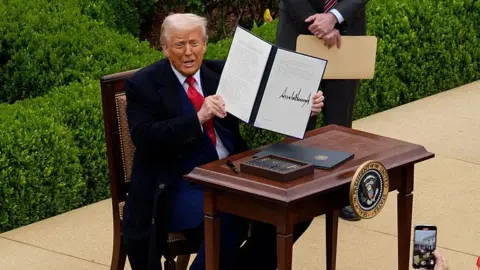Trump plans 25% tariffs for Japan and South Korea
 Getty Images
Getty ImagesThe US has said it is planning to impose a new 25% tax on products entering the country from South Korea and Japan, as President Donald Trump began sharing a batch of letters to leaders of countries outlining his latest tariff policies.
The messages came as the 90-day pause the White House placed on some of its most aggressive tariffs was set to expire.
Trump had suspended higher tariffs, with White House officials saying they would look to strike trade deals, after his initial announcement sparked outcry and turmoil on financial markets.
The higher duties had been set to resume on 9 July, but Trump has said he now plans to implement them on 1 August.
The letters shared by Trump on Monday showed little change from the rates announced in April, when he made his "Liberation Day" announcement, imposing a wave of new taxes on goods from various countries.
For example, at that time, he said he was looking to hit goods from Japan with duties of 24% and charge a 25% on products made in South Korea.
The president argues introducing tariffs will protect American businesses from foreign competition and also boost domestic manufacturing and jobs.
But economists say the measures will raise prices in the US and reduce trade. The three main share indexes in the US slipped on Monday, with Toyota's US-listed shares down 4%.
Japan sent more than $148bn in goods to the US last year, making it America's fifth biggest supplier of imports, after the European Union (EU), Mexico, China and Canada, according to US trade data. South Korea was also in the top 10.
As well as South Korea and Japan, Trump on Monday set out plans for a 40% tariff on goods from Myanmar and Laos, a 30% tariff on goods from South Africa and a 25% tariff on goods from Malaysia.
In all, White House press secretary Karoline Leavitt said the Trump administration planned to send letters to roughly a dozen countries on Monday and would share the notes on social media, with more letters to follow.
She disputed the suggestion that the shifting tariff deadlines from 9 July to 1 August might reduce the power of Trump's threats.
"The president's phone, I can tell you, rings off the hook from world leaders all the time who are begging him to come to a deal," she said.
After furore erupted when Trump first announced tariffs in April, the president quickly suspended some of the highest import taxes to allow for talks, while keeping in place a 10% levy.
'Busy couple of days'
Treasury Secretary Scott Bessent said he expected "a busy couple of days".
"We've had a lot of people change their tune in terms of negotiations. So my mailbox was full last night with a lot of new offers, a lot of new proposals," he told US business broadcaster CNBC.
Trump had initially described his April tariffs as "reciprocal", claiming they were required to fight back against other countries' trade rules he saw as unfair to US exports.
He has separately announced tariffs for key sectors, such as steel and cars, citing national security concerns, and threatened raise levies on other items, such as pharmaceuticals and lumber.
The multi-layered policies have complicated trade talks, with car tariffs a key sticking point in negotiations with Japan and South Korea.
So far, the US has struck agreements with the UK and Vietnam, as well as a partial deal with China. In all three of those cases, the agreements have raised tariffs compared with levels before Trump returned to the White House, while key issues remain unresolved.
The US has said a deal with India is close.
The EU is also engaged in talks, with reports suggesting officials in the bloc were not expecting to receive a tariff letter. A spokesperson for the EU also said the European Commission's president Ursula von der Leyen had a "good exchange" with Trump.
Just a few weeks ago, the US president had threatened the EU with a 50% tax unless it reached an agreement.
Last week, Trump said Japan could face a "30% or 35%" tariff if the country failed to reach a deal with the US by Wednesday.
